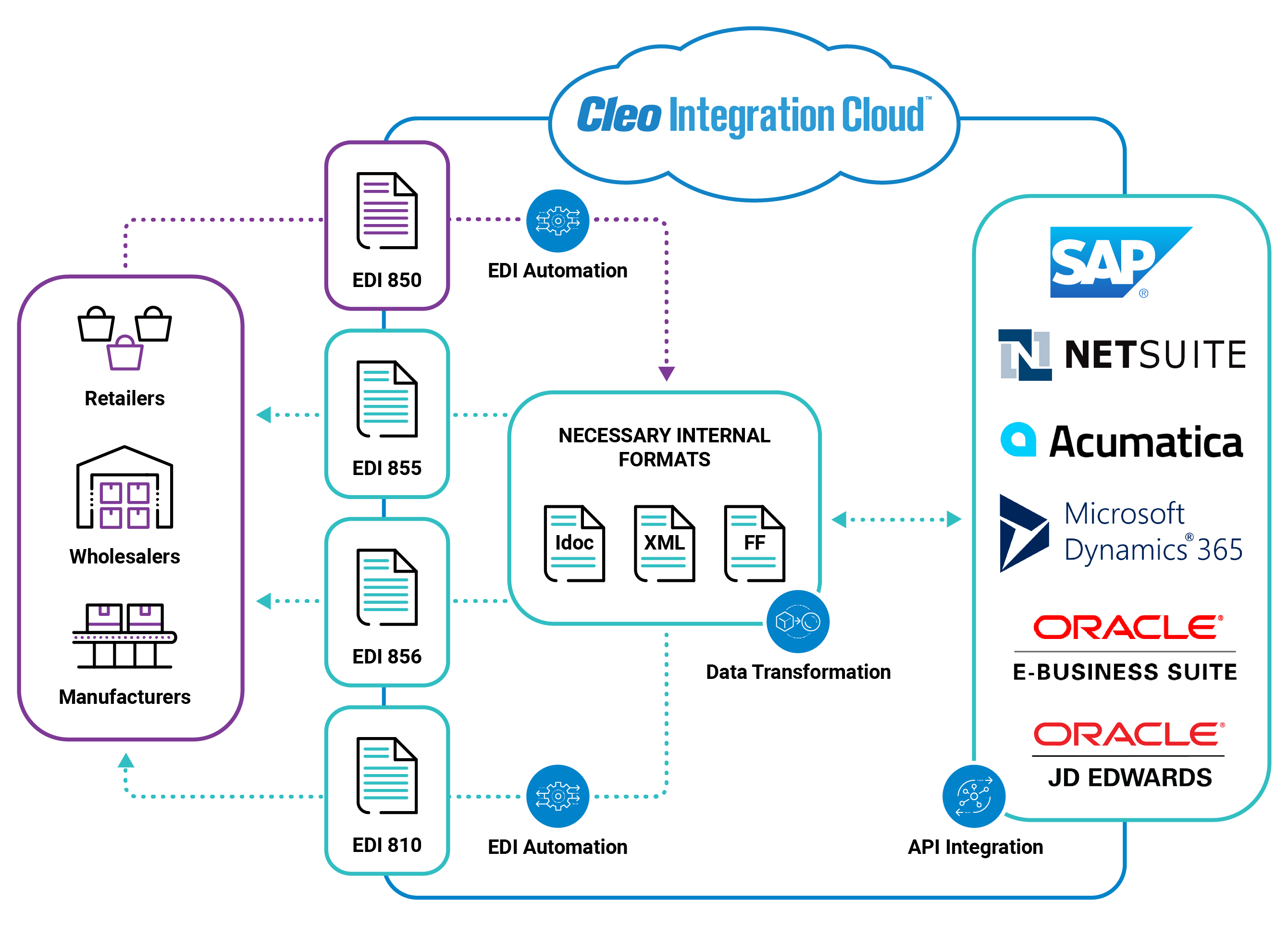What is an EDI System? Why Modern EDI Systems Are Crucial to Your Business

The B2B challenges that organizations face today are far different than they were only a few years ago. The demands of customers are constantly evolving, and the impetus is on today's enterprise to not only keep up with those demands but also prepare your EDI system for whatever comes next.
Here is everything you need to know about EDI systems:
- What is an EDI System?
- EDI System Components and Services
- Benefits of an Improved EDI System
- Scaling Your EDI System
- Complete B2B Control with a Modern EDI System
What is an EDI System?
An Electronic Data Interchange (EDI) system is a computer-based program used by trading partners to send and receive critical business messages (such as purchase orders, invoices, shipping notices, etc.) automatically. The EDI system replaces traditional paper-based communication methods like mail or fax with a digital exchange of business documents.
By automating previously paper-based transactions, EDI systems help organizations save time and get rid of expensive human errors. Similarly, an EDI platform allows one company to send and receive information from another company electronically and in a standardized format, thereby enabling paperless communication.
An EDI system is a set of components that allow companies to send, transform, and receive electronic data from one computer system to another. This process often includes the mapping of that data to and from internal applications or systems.
EDI System Components and Services
Robust EDI systems can automatically transmit EDI documents, as well as transform data to an internal format that can be ingested into an internal application, like an accounting solution or ERP system.
A complete EDI system has:
- A protected and dedicated transaction network that sends, receives, and encrypts the EDI transactions to your EDI trading partner
- An EDI translator application that formats and transforms your EDI transactions into the necessary format
- EDI mapping functionality to create automated bidirectional data flows from your internal business system to your trading partners. EDI mapping is a process of conversion in which EDI data is translated into a format that is better used in a new technical environment, such as an ERP system. During an EDI mapping event, data structures are translated from an EDI standard format (EDIFACT, ANSI X12, OFTP2, etc.) to a proprietary file that can be easily ingested into a back end system (CSV format, txt, SAP IDoc, Flat File, or another ERP specific format).
- EDI support and expertise to keep transactions flowing
A complete EDI system should look like something like this diagram, complete with each of the components mentioned above:
Read About the Future of EDI Automation

There are many EDI solutions that can readily handle one or more of the above EDI system functions; however, only a select few can do all 4 at a level that will enhance your supply chain.
Having a modern EDI software in place allows businesses to meet the needs of their customers in a way that is efficient, secure, and reliable.
A central integration system takes advantage of EDI in ways that drive true business value to your bottom line. Whether that means aggressively bringing on more trading partners, expanding into new geographic markets, or launching new revenue models like omnichannel or e-commerce, modern EDI integration throughout your digital ecosystem is critical.
Benefits of an Improved EDI System
Improving how you accomplish EDI provides many benefits to your organization, including how you interact with your business partners. Purchase orders, invoices, and other transactions within EDI order processing are the lifeblood of modern business, and enabling those processes ensures the reliable exchange of goods and services and ultimately dictates whether your business will make money.
When you rely on legacy and disparate systems that are complex, expensive to manage, or complicated to use, those trading partner relationships - and revenue streams - are in jeopardy.
5 benefits of a modern EDI system:
1. Embrace Standards
EDI standards are in place to minimize any potential communication complications that can lead to lost data, missed SLAs, and costly chargebacks. Modern EDI systems can take most B2B documents and transform and orchestrate any data, regardless of format. These include ANSI X12, EDIFACT, and Tradacoms standards and support formats like EDI, XML, and JSON, among others.
2. Speed and Time to Value
Enterprises with a central integration system can considerably cut their processing time via automation, which speeds up order-to-cash cycles and improves business efficiency. Instead of taking days or weeks to onboard a new partner, for example, modern, integrated EDI interfaces leverage prebuilt connections to get you 80 percent of the way there.
3. Automation and Accuracy
Once you've made the decision to migrate from your legacy environment, you no longer have to spend valuable time and employee resources on manual data entry and integration tasks. Instead, automated EDI solutions, including an EDI translator, expedite those processes, reduce the number of human-generated errors and help maintain EDI compliance.
4. Cost Savings
Modern EDI systems reduce costs and overhead that companies previously were responsible for. If enterprises are still relying on custom-coded legacy systems, the resources required to manage and maintain your bulky and cumbersome equipment are going to run higher than if you were using a modern EDI integration system.
5. Security
Companies can feel safe and secure when they have an EDI model in place. In fact, EDI solutions are designed to ensure security and only allow strict access to authorized users, and are usually equipped with archive tracking and audit trail capabilities. Companies are also able to share data securely across many communication protocols and security standards, to ensure EDI compliance with mandates in global business.
EDI remains the de-facto standard for most organization's critical B2B transactions and activities. Because of this, anytime a company begins the transition to a modernization effort, EDI system modernization is or should be at the forefront of those plans.
One of the primary reasons that an EDI modernization strategy is so critical to an enterprise's success is due to the level of scalability it provides. As companies take on more and more customers, being able to scale when necessary is fundamental in order to not simply keep those customers, but keep them happy.

Level Up Your Supply Chain: Explore Our EDI Solution
You’ve taken the first step towards a smoother supply chain by finding this blog - now discover how our EDI solution automates data exchange, saving you time and boosting efficiency.
Scaling Your EDI System
As your organization evolves and expands, it becomes increasingly tough to navigate the many transactional volumes that come with more customers and more orders. Having more customers than ever sounds great (and is), but if you are unable to effectively manage the needs of those customers, then you aren't doing your organization any favors.
As many as 95% of IT decision-makers EDI system modernization ambitions, but 38% of those IT managers lack the confidence in their capacity to scale to support digital transformation initiatives. That is quite a high number and shows just how serious the issue of scaling is in today's modern enterprise.
Further, what exactly happens to your total cost of ownership (TCO) when you try to scale with a traditional EDI managed services provider?
There is an added cost to onboard a new trading partner or to make any changes in order to gain EDI visibility.
Modern cloud-based EDI solutions aren't going to present your enterprise with hidden costs that you have no choice but to pay in order to scale.
Gain Complete B2B Control with a Modern EDI System
Despite reports of its premature death, moving EDI documents will remain a core part of the global business going forward. Whether you take advantage of modern EDI, however, and all its benefits is up to you.

Ready to Take Your EDI Research to the Next Level?
You've explored the benefits, now see how it applies to you! Get a personalized consultation on how our EDI solution can streamline your supply chain. Just provide some information for a free, no-obligation assessment.
If your business growth is being stifled by time-consuming manual processes and/or errors, consider a solution that accelerates end-to-end integration and revenue-generating processes.
Cleo Integration Cloud elevates your EDI integration processes and streamlines your B2B communications. Cleo Integration Cloud helps automate your EDI processes in order to connect, transform, and route your EDI and non-EDI transactions through your ecosystem without piling on the custom code.
Discover the benefits of using Cleo Integration Cloud for EDI by watching a variety of demo videos.


About Cleo
